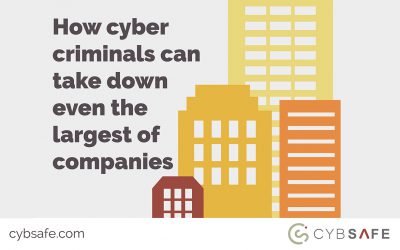Rewind
All the content from last year’s PeepSec, Impact and flagship industry events
UK general election: Hacking a very real threat to British political parties and voters
International Business Times
Five simple ways to avoid getting Staley-ed
Financial News
From paternalistic to user-centred security: Putting users first with value-sensitive design
Usable security research to date has focused on making users more secure, by identifying and addressing usability issues that lead users to making mistakes, or by persuading users to pay attention to security and make secure choices.However, security goals were set by...
If Google and Facebook can get scammed, how do you protect a small business?
The Guardian
Hacking the UK general election might be possible but ‘highly unlikely’
SC Magazine
The UK’s 13 most promising cybersecurity startups
Tech World
CybSafe uses Behavioural Science to Reduce Cyber Security Risk
Compare The Cloud
Finding security champions in blends of organisational culture
Security managers define policies and procedures to express how employees should behave to 'do their bit' for information security. They assume these policies are compatible with the business processes and individual employees' tasks as they know them. Security...
British start-up CybSafe launches service that uses behavioural science to reduce cyber security risk to businesses
Seed funding enables the start-up to tackle the biggest cyber threats to business: their own employees CybSafe, London, 26 April: CybSafe, a cyber security software company, today launches its platform to tackle the human aspect of cyber security using pioneering...
New platform uses behavioral science to cut cyber security risks
Beta News
Fitness trackers and wearable devices: How to prevent inference risks?
Wearable and personal devices are becoming more and more part of people's everyday lives. These devices produce enormous amount of personal data which are handled by third parties as authorized by the user. However, such third parties may be able to infer sensitive...
Growing positive security culture
This blog post explores how organisations can create, maintain and improve their security culture and addresses the questions one may have in regards to security culture. The author highlights three phenomena that actively prevent affected organisations from achieving...
Unwinding Ariadne’s identity thread: Privacy risks with fitness trackers and online social networks
The recent expansion of Internet of Things (IoT) and the growing trends towards a healthier lifestyle, have been followed by a proliferation in the use of fitness-trackers in our daily life. These wearable IoT devices combined with the extensive use by individuals of...
Cybersecurity is everyone’s responsibility: 5 ways to turbo charge your security practices
This blog post emphasises the need for organisation-wide security awareness and offers five recommendations that can improve personal security practises and defend organisations against cyber threats.
Social cybersecurity: Applying social psychology to cybersecurity
An introduction to the research of Jason Hong, Sauvik Das, Tiffany Hyun-Jin Kim and Laura Dabbish, who are investigating how social influence affects cyber security and testing how social influence techniques can improve people’s awareness and knowledge of...
Confusing cyber security terminology helps cyber criminals attack
Today’s cyber security terminology is cryptic and confusing. Which is exactly what criminals want. On Friday, 21st of October 2016, a group of cyber-criminals sent out a warning. They flooded some of the world’s largest websites with unprecedented volumes of traffic,...
What (or who) is public? Privacy settings and social media content sharing
When social networking sites give users granular control over their privacy settings, the result is that some content across the site is public and some is not. How might this content—or characteristics of users who post publicly versus to a limited audience—be...
Internet of Things: Security and privacy issues and possible solution
This paper explores how commonly used communication methods and information retrieval, typically carried out over the Internet via a variety of smart devices, can inadvertently transform the Internet into a hazardous platform due to its inherent propensity to make...
Priming and warnings are not effective to prevent social engineering attacks
Humans tend to trust each other and to easily disclose personal information. This makes them vulnerable to social engineering attacks. The present study investigated the effectiveness of two interventions that aim to protect users against social engineering attacks,...
Cyber hygiene insight report
A report that investigates users' cyberhygiene and provides insights and implications.
A comprehensive framework for cultivating and assessing information security culture
This study proposes a new framework to help organisations nurture a culture of information security. The framework consists of factors known to affect security behaviour, such as: management; risk assessment; policies; education; and conduct, among others.
